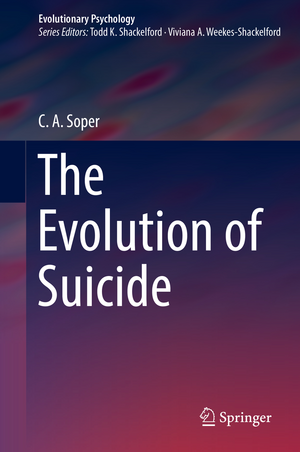The Evolution of Suicide: Evolutionary Psychology
Autor C A Soperen Limba Engleză Hardback – 3 aug 2018
This thought-provoking volume offers a distinctly human evolutionary analysis of a distinctly human phenomenon: suicide. Its ‘pain and brain’ model posits animal adaptations as the motivator for suicidal escape, and specific human cognitive adaptations as supplying the means , while also providing a plausible explanation for why only a relatively small number of humans actually take their own lives. The author hypothesizes two types of anti-suicide responses, active and reactive mechanisms prompted by the brain as suicide deterrents. Proposed as well is the intriguing prospect that mental disorders such as depression and addiction, long associated with suicidality, may serve as survival measures.
Among the topics covered:
· Suicide asan evolutionary puzzle.
· The protection against suicide afforded to animals and young children.
· Suicide as a by-product of pain and human cognition.
· Why psychodynamic defenses regulate the experiencing of painful events.
· Links between suicidality and positive psychology.
· The anti-suicide role of spiritual and religious belief.
In raising and considering key questions regarding this most controversial act, The Evolution of Suicide will appeal to researchers across a range of behavioral science disciplines. At the same time, the book’s implications for clinical intervention and prevention will make it useful among mental health professionals and those involved with mental health policy.
| Toate formatele și edițiile | Preț | Express |
|---|---|---|
| Paperback (1) | 945.14 lei 6-8 săpt. | |
| Springer International Publishing – 30 ian 2019 | 945.14 lei 6-8 săpt. | |
| Hardback (1) | 951.14 lei 6-8 săpt. | |
| Springer International Publishing – 3 aug 2018 | 951.14 lei 6-8 săpt. |
Preț: 951.14 lei
Preț vechi: 1159.94 lei
-18% Nou
Puncte Express: 1427
Preț estimativ în valută:
182.03€ • 188.04$ • 151.49£
182.03€ • 188.04$ • 151.49£
Carte tipărită la comandă
Livrare economică 25 martie-08 aprilie
Preluare comenzi: 021 569.72.76
Specificații
ISBN-13: 9783319772998
ISBN-10: 3319772996
Pagini: 330
Ilustrații: XV, 289 p. 14 illus.
Dimensiuni: 155 x 235 mm
Greutate: 0.61 kg
Ediția:1st ed. 2018
Editura: Springer International Publishing
Colecția Springer
Seria Evolutionary Psychology
Locul publicării:Cham, Switzerland
ISBN-10: 3319772996
Pagini: 330
Ilustrații: XV, 289 p. 14 illus.
Dimensiuni: 155 x 235 mm
Greutate: 0.61 kg
Ediția:1st ed. 2018
Editura: Springer International Publishing
Colecția Springer
Seria Evolutionary Psychology
Locul publicării:Cham, Switzerland
Cuprins
Introduction.- Reviewing the options: Noise, adaptation, by-product.- Suicide as a by-product of pain and human cognition.- Shiltons: Lat-line, anti-suicide defenses.- Common mental disorders (CMDS) as Shiltons.- Pain-type Krols: Frontline anti-suicide mechanisms.- Brain-type Krols: Restricting access to suicide idea.- Summary, conclusion, implications.
Notă biografică
C A Soper is a psychotherapist with particular experience in helping people with addiction problems and those dealing with the aftermath of suicide and other bereavements. Born in London, he has degrees from University of Cambridge and University of London, and is an accredited member of the British Association for Counselling and Psychotherapy. This book is based on doctoral research undertaken with University of Gloucestershire in England, which resulted in the award of a PhD. Soper lives and practices in Lisbon, Portugal.
Textul de pe ultima copertă
This thought-provoking volume offers a distinctly human evolutionary analysis of a distinctly human phenomenon: suicide. Its ‘pain and brain’ model posits animal adaptations as the motivator for suicidal escape, and specific human cognitive adaptations as supplying the means , while also providing a plausible explanation for why only a relatively small number of humans actually take their own lives. The author hypothesizes two types of anti-suicide responses, active and reactive mechanisms prompted by the brain as suicide deterrents. Proposed as well is the intriguing prospect that mental disorders such as depression and addiction, long associated with suicidality, may serve as survival measures.
Among the topics covered:
· Suicide as an evolutionary puzzle.
· The protection against suicide afforded to animals and young children. · Suicide as a by-product of pain and human cognition.
· Why psychodynamic defenses regulate the experiencing of painful events.
· Links between suicidality and positive psychology.
· The anti-suicide role of spiritual and religious belief.
In raising and considering key questions regarding this most controversial act, The Evolution of Suicide will appeal to researchers across a range of behavioral science disciplines. At the same time, the book’s implications for clinical intervention and prevention will make it useful among mental health professionals and those involved with mental health policy.
Among the topics covered:
· Suicide as an evolutionary puzzle.
· The protection against suicide afforded to animals and young children. · Suicide as a by-product of pain and human cognition.
· Why psychodynamic defenses regulate the experiencing of painful events.
· Links between suicidality and positive psychology.
· The anti-suicide role of spiritual and religious belief.
In raising and considering key questions regarding this most controversial act, The Evolution of Suicide will appeal to researchers across a range of behavioral science disciplines. At the same time, the book’s implications for clinical intervention and prevention will make it useful among mental health professionals and those involved with mental health policy.
Caracteristici
Provides theoretical basis for suicide as a human behaviour Challenges automatic acceptance of pharmacologic approaches to treatment Brings together research from a variety of fields Provides new scientifically derived insights into mental disorders a suicidal behavior









